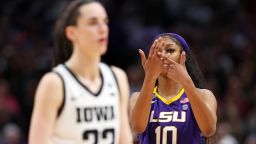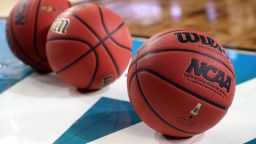Editor’s Note: Amy Bass (@bassab1) is professor of sport studies at Manhattanville College and the author of “One Goal: A Coach, a Team, and the Game That Brought a Divided Town Together” and “Not the Triumph but the Struggle: The 1968 Olympics and the Making of the Black Athlete,” among other titles. The views expressed here are solely hers. Read more opinion on CNN.
Something incredible happened this past weekend: Americans went to bed Sunday night talking about women’s basketball and woke up Monday morning still going on and on about it. It’s almost hard to believe, considering this year’s tournament is just the second time that the NCAA has used the same language and branding for the women — that giant MARCH MADNESS logo, historically reserved for the men’s side, running bold and bright beneath the feet of superstars Angel Reese of LSU and Caitlin Clark of Iowa.

That change came after gender disparities surfaced in a deluge of social media posts, initiated by Oregon’s Sedona Prince (who has entered this year’s WNBA draft), in 2021, noting inequities in everything from the food to the weight room facilities. This year, women’s Final Four ticket prices were higher than the men’s — albeit somewhat because Dallas’s American Airlines Center, where the women’s games were held, is significantly smaller than NRG Stadium in Houston, the site of the men’s finals (normally a space for football and rodeo).
Instead of having to make the case for women’s basketball (again), we know by dint of the buzz and controversy stirred by Reese and Clark (and their critics) that it’s arrived. We are, days later, still debating the ethics of trash talk and the problem of bad, or at the very least inexperienced, officiating.
This isn’t to say sexism in sports is fixed or to discount the important questions about race being asked after LSU’s defeat of Iowa in the women’s final. It is to emphasize that without question, and on many levels, this year’s NCAA tournament, women’s and men’s, with LSU and UConn crowned champions, was one for the ages.
Here are four key takeaways:
1. We might be talking about the women, but we aren’t talking about them the same way
After Iowa’s women felled the mighty defending champions from the University of South Carolina Friday night in a game that netted ESPN a record-breaking 5.5 million viewers, South Carolina coach Dawn Staley used the postgame microphone to double down on a stance she has taken throughout the season. She shrewdly and astutely called out media narratives that portray Black women on the court as overly physical and aggressive.
According to the Greenville News, Iowa’s coach, Lisa Bluder, said before Friday’s game that she was told that rebounding against Staley’s team was akin to “going to a bar fight.” After the loss, Staley was direct in her rejection of this characterization: “We’re not bar fighters. We’re not thugs.” She pushed back against describing teams like her Gamecocks in such terms while designating White players as “passionate” and “fierce.”
Staley’s stance — “I’m not changing” — meshed well with that of LSU’s Reese, the “Bayou Barbie” who wore a literal crown on top of her championship hat, and tweeted back in January that she understood all too well that her style on and off the court was “too hood” and “too ghetto” for mainstream basketball narratives. Before LSU had captured its historic first title, Reese challenged fans and media alike to “normalize women showing passion for the game instead of it being ‘embarrassing.’”
All too often, even when women win, they cannot win — just ask the USWNT about the response to their 13-0 World Cup blowout of Thailand in 2019. But the policing of women’s athletic passion isn’t doled out equally, evidenced by the reaction to Reese’s so-called taunting of Clark in the last seconds of the championship game, with the racialized vitriol that accused her of being “classless” or “unsportsmanlike” demonstrating vividly the double standard Black athletes are all too familiar with.
“When other people do it, y’all don’t say nothing,” Reese said after the championship game. “This was for the people who look like me.” The response to Reese’s “you can’t see me” gestures, especially when viewed in the context of Staley’s remarks, vividly demonstrates the point. Those who lost their minds on Twitter (and yes, we are looking at you, Dave Portnoy) are able to pick and choose whose on-court swagger is part of the game — Clark herself is no stranger to trash talk and hand gestures -— and whose gets called out in offensive terms.
2. We love an underdog
That sound that kept popping across the last few weeks of our lives was that of brackets being smashed into bits. Number 1-seeded Purdue’s men’s team made the earliest top seed exit, felled by Fairleigh Dickinson on St. Patrick’s Day, only the second time a number one seed has fallen in the first round. The other number one seeds met their exits soon after, with none left standing by the end of the Sweet Sixteen. On the women’s side, two number one teams, Stanford and Indiana, met their fate in the second round — a turn of events not seen since 1998.
Every year, March Madness features at least one good underdog story, with a low-seeded David taking down a top-seeded Goliath. But this year was extra, showing how the magic of a low-seeded triumph, an unforeseen victory, often brings a far more passionate reaction than an anticipated win. This year was by no means the first time there was a men’s Final Four devoid of number one teams — it happened as recently as 2011 — but this was the first time they went out so early.
Just as Americans love a good rags-to-riches Horatio Alger story, one that reinforces the belief in hard work and a little bit of luck regardless of circumstances, fans thrill at the shock and awe of a top seed going down early and, at least this year, often. Teams like FDU and Florida Atlantic (on its improbable run to the Final Four) became men’s college basketball’s version of Rocky Balboa, allowing fans to bear witness that, indeed, sometimes David actually wins, and for whatever reason, there is virtue — and even joy — in that.
3. Yes, we love the Cinderellas, but we also love the GOATs
While LSU’s Reese netted player of the tournament honors, Iowa’s Clark takes home the player of the year crown. While Clark seemed to deflate in the latter part of the championship game after her hotly debated technical foul, there is no doubt that her performance across the tournament set her legacy in stone.

Against South Carolina in the semis, Clark pulled down 41 points, six rebounds and eight assists, ending the Gamecocks’ 42-game winning streak and putting her team into the championship game. In the Elite Eight against Louisville, she nailed the first 41-point triple-double in NCAA tournament basketball history (and yes, to those of you who always ask, man or woman, and in case you really want to keep score, it was her 11th triple-double). While kudos came from everyone from Billie Jean King to LeBron James, it was Magic Johnson who tried to put it into the best perspective.
“What makes Caitlin’s 40-point triple-double so special is the fact so many player never had one,” he tweeted. “Not me, Michael Jordan, or Larry Bird!”
4. The thrill of a good game breaks through just about everything else
While talk about sport-washing has surrounded everything from the men’s World Cup to the LIV golf tournament, there is no doubt that a thrilling sporting event can make it feel like the world has no troubles. Whether it was Clark’s awesome numbers, the FDU-believe-in-magic win, Lamont Butler’s buzzer beating jumper that got San Diego State into the final over a surging Cinderella Florida Atlantic squad or LSU finally nabbing a title, lots of things relaxed in the backseat while the electrifying competition took center stage.
The seemingly never-ending discussion of name, image and likeness (NIL) regulation (or lack thereof), for example, faded into the background. This despite the NCAA, now led by former Massachusetts governor Charlie Baker, being the subject of a Congressional panel during the tournament. Watching the hearings, sports historian Victoria Jackson tried to pop America’s March Madness bubble to provide context as to the absurdity of the tournament. “I encourage you to travel outside the US and explain the multi-billion dollar sports industry played in by ‘amateurs’ led by coaches making millions,” she tweeted. “Not only will you be the life of the party, blowing minds, it will serve as a needed exercise to step outside the US college sports bubble and reconsider what is good here and what isn’t.”
The excitement and visibility of the women’s side — a record-breaking 9.9 million watched the final with a peak viewership of 12.6 million — also gave pause to the fact that professional women’s sports, which are unquestionably growing, still lag behind the men, never reaching the level of watercooler conversation that the LSU versus Iowa title game created this year. That’s largely because the next step for the dozens of star players on multiple women’s teams, the WNBA, simply does not have room for the amount of talent on display these last few weeks.
Get our free weekly newsletter
- Sign up for CNN Opinion’s newsletter.
- Join us on Twitter and Facebook
As these college teams continue to raise the bar, making perennial favorites like South Carolina, Stanford and UConn increasingly uncomfortable, the congested marketplace of women’s professional basketball — just 144 roster slots to go around — means that once players like Reese and Clark find their teams, likely in the 2024 draft, the league needs to think not only of expansion (always something to be cautious of) but also development, with no current parallel to the NBA’s G league. While Phoenix Mercury star Brittney Griner’s Russian imprisonment shed a much-needed spotlight on why so many of the WNBA’s best choose to play elsewhere as well, earning more money than their domestic contracts offer, it also serves as a cautionary tale for those who don’t — can’t — make it to the WNBA at all.
So, what comes next, we do not know. But what just happened? Yeah, it was good.
PS: Iowa doesn’t get an invite to the White House. They lost. Let’s not do that. Let’s not go there.






